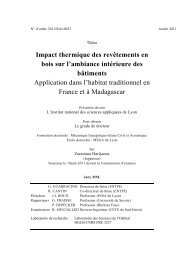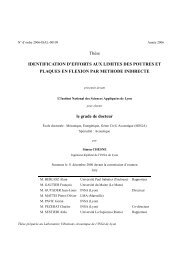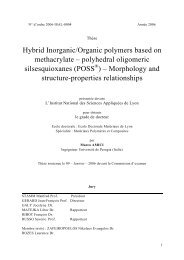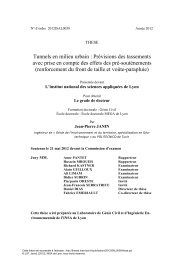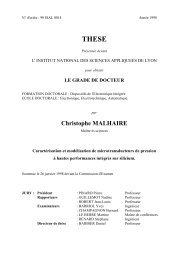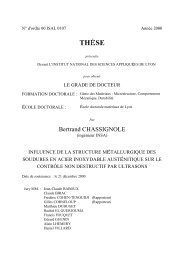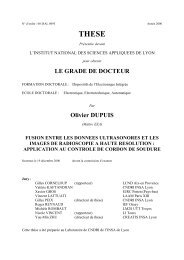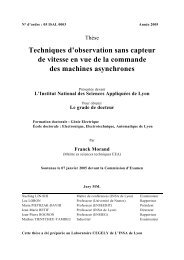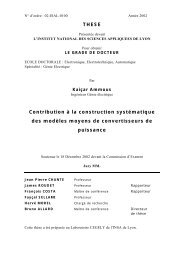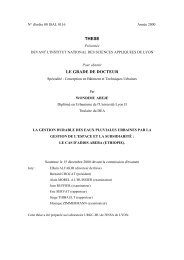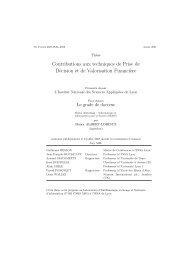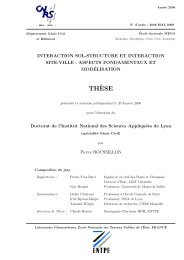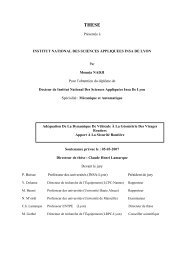Calcination des Sédiments de Dragage Contaminés - Thèses de l ...
Calcination des Sédiments de Dragage Contaminés - Thèses de l ...
Calcination des Sédiments de Dragage Contaminés - Thèses de l ...
You also want an ePaper? Increase the reach of your titles
YUMPU automatically turns print PDFs into web optimized ePapers that Google loves.
CALCINATION DES SEDIMENTS DE DRAGAGE CONTAMINES. ETUDE DES PROPRIETES<br />
PHYSICO-CHIMIQUES<br />
Les travaux présentés s’inscrivent dans le cadre du procédé NOVOSOL ® développé par la société<br />
SOLVAY S.A. qui vise le traitement et la valorisation <strong><strong>de</strong>s</strong> sédiments <strong>de</strong> dragages contaminés en métaux lourds<br />
et en matières organiques. Ce procédé <strong>de</strong> traitement comporte <strong>de</strong>ux étapes <strong>de</strong> traitements : chimique<br />
(phosphatation) et thermique (calcination). Les travaux présentés dans cette thèse ont porté sur le traitement<br />
thermique. Notre objectif est <strong>de</strong> comprendre le comportement physico-chimique du sédiment pendant la<br />
calcination. La connaissance <strong><strong>de</strong>s</strong> ces propriétés permettra d’utiliser le sédiment calciné dans différentes filières<br />
<strong>de</strong> valorisation, notamment le génie civil. Deux sédiments d’origines et <strong>de</strong> propriétés différents ont été étudiées.<br />
Après la caractérisation physico-chimique, l’étu<strong>de</strong> du comportement <strong><strong>de</strong>s</strong> métaux lourds et <strong><strong>de</strong>s</strong> composés<br />
organiques pendant la calcination a été examiné. La distribution <strong><strong>de</strong>s</strong> métaux lourds entre la phase soli<strong>de</strong> et la<br />
phase gazeuse a été étudiée et les résultats obtenus ont permis <strong>de</strong> montrer que l’essentiel <strong><strong>de</strong>s</strong> métaux lourds est<br />
piégé dans le soli<strong>de</strong>. Les tests <strong>de</strong> disponibilité <strong><strong>de</strong>s</strong> métaux ont montré que les métaux lourds présents dans le<br />
soli<strong>de</strong> traité sont bien stabilisés. Les résultats montrent aussi que la calcination renforce la stabilité <strong><strong>de</strong>s</strong> métaux<br />
lourds. La dégradation <strong><strong>de</strong>s</strong> composés organiques est effective à partir <strong>de</strong> 400°C.<br />
Dans la secon<strong>de</strong> partie, le comportement textural et structural du sédiment sous l’effet <strong>de</strong> la température a été<br />
étudié à l’échelle <strong>de</strong> laboratoire et à l’échelle pilote. Une augmentation <strong>de</strong> la surface spécifique est observée<br />
jusqu’à 400°C suivie d’une importante réduction qui s’accompagne d’une <strong>de</strong>nsification et d’un grossissement<br />
<strong><strong>de</strong>s</strong> particules. L’augmentation <strong>de</strong> la surface spécifique observée jusqu’à 400°C s’explique par la décomposition<br />
<strong><strong>de</strong>s</strong> matières organiques qui entraîne une augmentation <strong>de</strong> la porosité et donc <strong>de</strong> la surface spécifique ; au <strong>de</strong>là <strong>de</strong><br />
400°C, les évolutions conjuguées <strong><strong>de</strong>s</strong> propriétés sont dues au frittage thermique <strong><strong>de</strong>s</strong> sédiments induit par la<br />
formation <strong>de</strong> joint <strong>de</strong> grains par transport <strong>de</strong> matière à haute température. Les calcinations réalisées en four<br />
tournant pilote ont permis <strong>de</strong> montrer que les propriétés physiques (surface spécifique, <strong>de</strong>nsité, granulométrie)<br />
du sédiment dépen<strong>de</strong>nt <strong><strong>de</strong>s</strong> paramètres <strong>de</strong> calcination (temps <strong>de</strong> séjours, température <strong>de</strong> calcination, débit <strong>de</strong><br />
chargement, angle d’inclinaison du four). D’une manière générale, les résultats montrent qu’une augmentation<br />
<strong>de</strong> la surface spécifique est liée à la fois à la réduction <strong>de</strong> la température <strong>de</strong> calcination et à l’allongement du<br />
temps <strong>de</strong> séjour. On note aussi un bon accord entre les résultats obtenus à l’échelle laboratoire par rapport à ce<br />
qui a été obtenu à l’échelle pilote. La taille <strong><strong>de</strong>s</strong> particules augmente quand la température <strong>de</strong> calcination est<br />
élevée à cause du frittage thermique. Ces résultats montrent qu’il est possible d’obtenir <strong><strong>de</strong>s</strong> produits en fin <strong>de</strong><br />
procédé ayant <strong><strong>de</strong>s</strong> propriétés très différentes. Cela donne <strong><strong>de</strong>s</strong> perspectives intéressantes en terme <strong>de</strong> valorisation.<br />
CALCINATION OF CONTAMINATED DREDGED SEDIMENTS. STUDY OF CHEMICALS AND<br />
PHYSICALS PROPERTIES.<br />
The work presented <strong>de</strong>als with the NOVOSOL ® process <strong>de</strong>veloped by SOLVAY S.A. Company. This<br />
aim to <strong>de</strong>compose the organics and stabilize heavy metal containing contaminated dredged sediment for<br />
beneficial reuse. This process comprises two stages: chemical treatment (addition of soluble phosphate) and the<br />
thermal treatment (calcination). Research presented is focused on the thermal treatment. Our objective is to<br />
un<strong>de</strong>rstand the physicochemical behaviour of the sediment during the calcination. The un<strong>de</strong>rstanding of the<br />
evolution on these properties will help for the beneficial reuse of the treated sediment in various industry such as<br />
the civil engineering.<br />
The characterization performed was followed by the investigation of the behaviour of heavy metals and<br />
the organic compounds during the calcination. The distribution of heavy metals between the solid phase and the<br />
gas phase were studied during the calcination and the result obtained showed majority of heavy metals are<br />
trapped in the solid. The leaching tests performed showed that heavy metals present in the residue are well<br />
stabilized. The <strong>de</strong>gradation of the organic compounds is effective at 400°C.<br />
Afterwards, the structural change of the sediment during thermal treatment was investigated at<br />
laboratory scale and at pilot scale. An increase in specific surface is observed until 400°C followed by a<br />
signification reduction accompanied by a <strong>de</strong>nsification and growing of the particles. The increase in specific<br />
surface observed is the formation of pores observed by due to the <strong>de</strong>composition of organics from 400°C to<br />
1000°C. The combined evolutions of properties are due to the thermal sintering of the sediments induced by the<br />
formation of grain boundary driven by the mass transport at high temperature. The calcination in a rotary kiln<br />
showed that the physical properties (the specific surface, <strong>de</strong>nsity, particle size) of the sediment <strong>de</strong>pend on the<br />
calcination. parameters such as the resi<strong>de</strong>nce time, calcination temperature, sediment flow rate were investigated.<br />
The results showed that the higher is the temperature the stronger is the sintering process that led to the<br />
significant particle growth.



